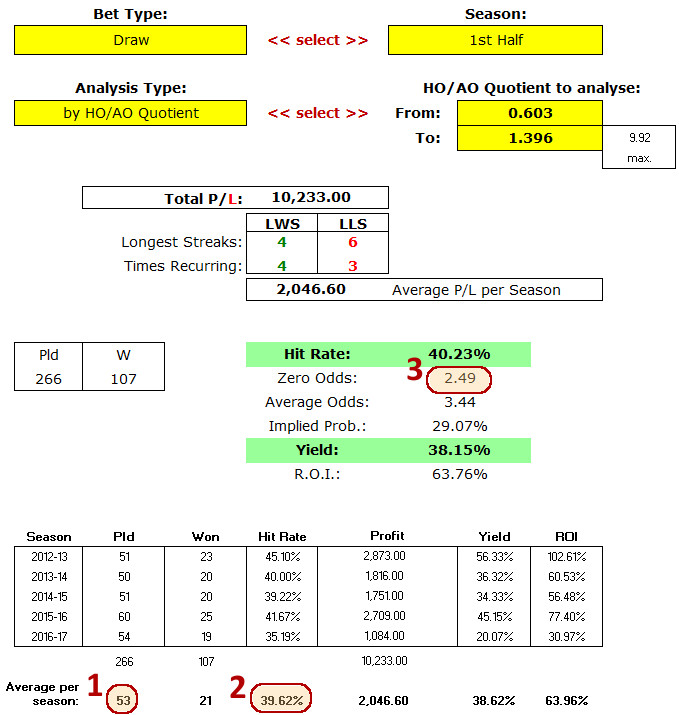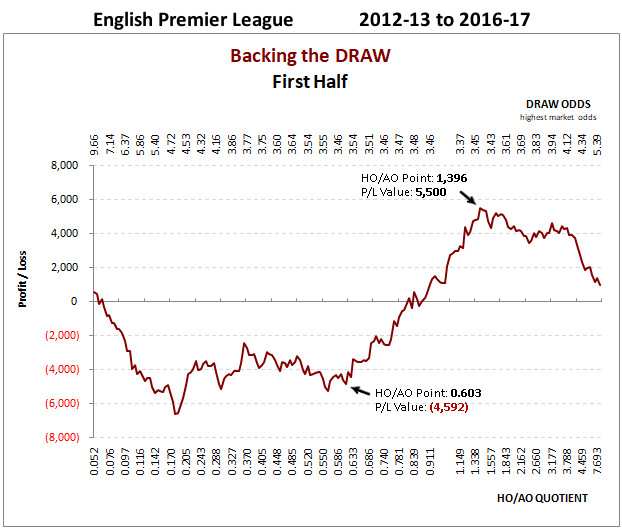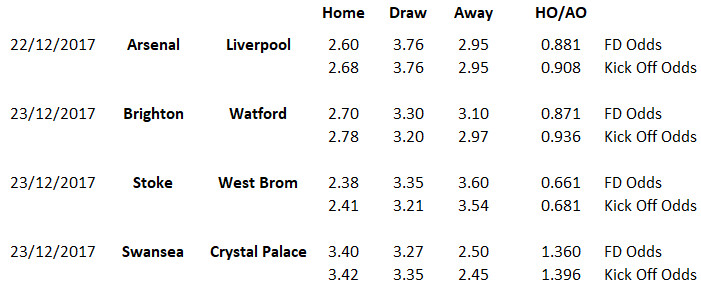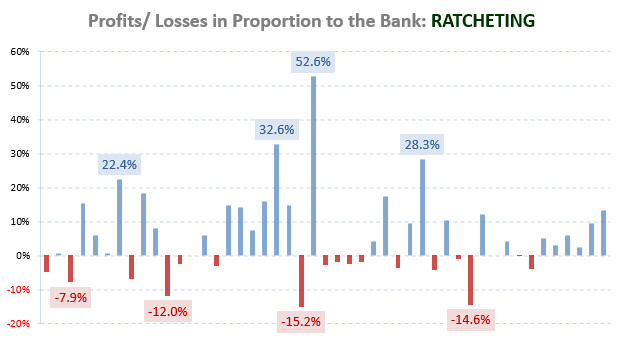
Our 7th generation of HDAFU tables introduces the HO/AO quotient as a selection criterion which has the effect of making your systems less volatile and your portfolio of systems more viable.
Furthermore, the HO/AO Quotient removes the need to stay in front of the computer in the last hour before kick-off and allows you to compile your portfolio of bets well in advance, hence reducing the stress factor and possible human error.
 Image: StockLite (Shutterstock)
Image: StockLite (Shutterstock)What is a HO/AO Quotient?
The division of HO (Home Odds) by AO (AO Odds) reflects the “strength” of the teams. This makes upcoming games comparable with past matches, of which the results are known.
When building the quotient, we’re not asking ourselves questions like “Are these teams really equal?” or, “Is the favourite priced correctly?” We do not recalculate 1X2 odds; we simply use market prices and assume that the bookmakers have taken statistics into account and reflected public opinion (market pressures) as well as they possibly could do when setting their odds.
The HO/AO quotient is therefore an ideal device for comparing an upcoming match with the nearest batch of equivalent games against teams of a similar perceived strength to the opponent under analysis.
If for example, Liverpool are 1.34 to beat West Ham and West Ham are 11.0 to beat Liverpool, it makes sense to look at comparable matches where other teams carried similar prices in their respective home and away games in the past.
How to Calculate the HO/AO Quotient
As an example we will use the match Arsenal against Liverpool on 22/12/2017.
The evening before the match, the home win (Arsenal) was priced at 2.60, and the away win (Liverpool) at 2.95.
For the HO/AO quotient you simply divide the home odds (HO) by the away odds (AO).
2.60 divided by 2.95 = 0.881
That’s it!
Of course, if you would use the odds at kick-off then your quotient will be different, the home win (Arsenal) was then priced at 2.68, and the away win (Chelsea) at 2.95.
2.68 divided by 2.95 = 0.908
We will have closer look at these difference in the course of this article and explore if they actually matter and how much they matter.
What does the HO/AO Quotient Tell Us About the Comparative Strength of Teams?
When looking at the 2013-18 EPL HDAFU table, the following classifications become apparent when dividing games into ‘perceived strength’:
- HO/AO: up to 0.225
The home team is the clear favourite with a very good chance of winning (the home team is the overwhelming favourite)
For example, Liverpool vs. Brighton on the 13/5/2018 - HO/AO: 0.226 to 0.499
The home team is definitely stronger than the away team, but there is also a good chance of a draw in the game (fluctuating opinion between home or draw)
For example, Swansea vs. Stoke on the 13/5/2018 - HO/AO: 0.500 to 0.788
It is not really clear in which direction the game will develop (no overwhelming favourite)
For example, West Ham vs. Everton on the 13/5/2018 - HO/AO: 0.789 to 1.751
The chance of a draw is quite high as both teams are perceived to be of equal strength (no overwhelming favourite)
For example, Stoke vs. Crystal Palace on the 05/05/2018 - HO/AO: over 1.752
The home team is perceived as being much weaker than the away team; the public feels that it could be an away win (the perceived favourite is the away team)
For example, Southampton vs. Man City on the 13/5/2018
If you are in the possession of the 2013-18 EPL HDAFU table then go to the data tab and check a few matches and their HO/AO quotients and see if you agree with the games being in the above classifications.
Alternatively, calculate the HO/AO quotients using before kick-off odds that you can retrieve from any odds comparison site.
Now, continue with the exercise and check against the actual distribution of results. You will quickly see that they hardly distribute according to the expectations (HO/AO clusters). That’s what makes 1X2 betting so very tricky and the HO/AO quotient so handy.
Finding a System Using the HO/AO Quotient
We now come to the practical part of this article. If you have not yet downloaded our HDAFU Show Table, then you can do it now here; all the following examples are being carried out using this show table.
It is a fully functional table and its only limitation is that it is an expired table and cannot be used for the forthcoming season. Of course, it can be used for backtesting its functionality against the previous season (2017-18).
The size of this Excel .XLSX workbook is 4.2 MB
(1) Find an HO/AO Cluster in the ‘IP’s by HOAO’ tab in which the Curve Goes Steadily Upwards
 Image 1: P/L Simulation of ‘Backing the Draw’ in the first half
Image 1: P/L Simulation of ‘Backing the Draw’ in the first halfAbove screenshot shows you ‘Backing the Draw’ in the first half.
It is a nice, steady upwards curve and stretched over almost a third of the whole graph. This is why we are going to look at this HO/AO cluster for this article.
(2) Check in the ‘System Picker’ tab what to Expect
 Image 2: System Picker example
Image 2: System Picker example- The expected number of matches to bet on the following season: 53
To diversify your portfolio, you are looking ideally for at least 500 bets in one season but you certainly want to avoid having too many small individual systems in your portfolio. Just remember, the more restrictive your selection criteria the higher the risk of deviation from the expectations.
50 bets in an individual system is a very good number (that means that you only have to identify 10 different systems to populate a portfolio with 500 bets in total), and even better if it has been achieved over all five previous seasons.
- The expected hit rate: 39.62%
Please keep in mind that the lower the hit rate the more volatile a system is to longer losing streaks. Here’s an article on that topic: The Science of Calculating Winning and Losing Streaks
If your system has a probability of 40% to win then the maximum length of a losing streak may be as long as 8 bets in a row.
Keep that in mind and try to avoid too many low hit rate systems in your portfolio.
As a side note, you will be expecting with this system a hit rate of 39.62%. However, it is very unlikely that it will be absolutely spot on. Compared with the hit rates of the previous five seasons the average fluctuation (deviation) expected is 2.55% but it may be even as high as the maximum deviation which in this case was 5.48%.
This is a risk measurement and I will address and explain the calculations and their interpretations in another article about ‘How to Construct a Portfolio’.
- The Zero Odds: 2.49
This is actually the most important figure when using the HDAFU Tables to determine if you take the system in your portfolio of bets or not.
Taking the expected deviation (2.55%) into account you are looking at ‘Zero’ odds between 2.34 and 2.65; even taking the max. deviation (5.48%) into account, the ‘Zero’ odds are still as low as 2.88.
In this example, everything above the ‘Zero’ odds of 2.49 was a value bet! If you would have aimed constantly for odds above 2.88, you would have been playing on the absolutely safe side.
As you are looking at a system with average odds of 3.44 (the figure below the ‘Zero odds’ in the above screenshot) the timing of your bet would hardly have mattered. Even if you don’t always have access to the highest odds in the market, e.g. because of territorial restrictions, then it would have been safe to include this system in your portfolio because of the likelihood of achieving draw odds above 2.49 (or even 2.88) ‘Zero’ odds.
Again, as previously mentioned, the calculations and their interpretations will be addressed in detail in another article.
(3) Decide if to Include the System in your Portfolio
Our example above was definitely a system worthy of inclusion in the 2017-18 portfolio. It had everything you would be looking for:
- 50 bets minimum per annum
- an acceptable hit rate and
- delightfully low ‘Zero’ odds for the draw
Feel free to check yourself how this system would have performed for you during the 2017-18 season.
Here’s the answer: In the end 55 bets were played, of which 21 won (38.18% hit rate) with a profit of over 1,500 units using 100 unit flat stakes.
Why does the HO/AO Quotient Make an Analysis Less Volatile?
Here’s a close up screenshot from the Inflection Point graph above (image 1) and the odds seem to be disorganised and unordered:
 Image 3: Inflection Point graph – corresponding draw odds
Image 3: Inflection Point graph – corresponding draw odds
The HO/AO Quotient is a device for grouping matches into ‘comparable strengths’ of the teams involved (home odds divided by away odds), with the draw variable removed.
If you would be picking your system by odds then draw odds up to 3.54 could be draws odds for all kind of matches; matches between a strong favourite at home, equally matched teams, or the favourite being the away team, and so on.
With the HO/AO Quotient in our example: 0.603 to 1.396 we are only targeting teams in group 3 ≫ It is not really clear in which direction the game will develop (no overwhelming favourite) and group 4 ≫ The chance of a draw is quite high as both teams are perceived to be of equal strength (no overwhelming favourite)
For example, if there is a strong favourite involved in the game then the HO/AO Quotient approach filters these games out, even if the draw odds may be lower than 3.54.
Using the HO/AO Quotient slims down the number of available bets to an average of 53 bets with an expected hit rate of 39.62%. The expected profit is: 2,046.60 units per annum when staking 100 units flat.
Would you have used the ‘IP’s by Odds’ instead you would have likely chosen the odds cluster from 3.30 to 3.65. This would have provided you with a higher number bets per annum (87) but with only a 33.33% expected hit rate and a lower profit expectation of 1,322.40 units. Furthermore, the system would have been more volatile: an expected deviation of 2.78% (as compared with 2.55%) with a maximum deviation of 6.66% (as compared with 5.48%).
By slimming down the number of bet candidates and targeting bet selection via the HO/AO quotient taking the strength of the teams into account, the system becomes less volatile.
Draw systems especially benefit from the HO/AO Quotient, but others as well.
At What Time Should the HO/AO Quotient be Calculated and Which Odds should be Used
All Summer and Winter League HDAFU Tables use 1X2 odds recorded at or close to the end of the ante-post market. In other words, just prior to kick-off in all games. In the majority of cases, these odds are courtesy of Pinnacle, the most popular low-margin bookmaker around. In all other cases, the 1X2 odds used are the highest bookmaker odds at www.Oddsportal.com from a selected panel of their bookmakers according to our own personal settings.
Ideally, the closer to kick-off you calculate the HO/AO quotients for your system(s), the closer you are going to be to the HO/AO quotients calculated and used in the HDAFU simulations. Preferably, you should wait until team news is released before relying on where the odds settle thereafter.
Calculating the HO/AO Quotient at another Time
If you are for some reason unable to calculate the HO/AO quotient close to kick-off on match days then please, don’t worry too much.
Here’s an example weekend from the first half of the 2017-18 EPL season:
 Image 4: Calculating HO/AO Quotients at different times
Image 4: Calculating HO/AO Quotients at different timesAs you can see all four matches that would have fitted the criteria of being in the HO/AO 0.603 to 1.396 quotient cluster would still have been in the group of betting candidates even when using odds at the close of the match.
Only the Swansea vs. Crystal Palace match may have drifted out of the cluster. The other three games remained solidly within their clusters so that it didn’t matter at all how their odds changed during the ante-post market.
I hope this article has cleared up any confusion caused by the introduction of the HO/AO Quotient to our 7th generation HDAFU tables. However, if you are still not sure, then please feel free to ask any questions via the comment section below.








I need clarification on the following please. Apologies if this has been answered, only I looked first of course.
Q1. If the game that qualified initially drops outside the quotient before KO, should I still back it?
Q2. If the game didn’t qualify initially but dropped into the quotient range in the run up to KO.
The way I view the above is;
If the game was initially outside the quotient a d dropped into it (q.2) I would avoid as market has distorted the price due to bias.
But I am confused with q.1….as it qualified originally, I perceive it as having more value now even though outside the quotient range before KO.
Always appreciate your replies.
Thank you,
Mike
Hi Mike,
I’ve got the rule in betting that if something is in doubt, then leave it. It’s always better not to risk anything than to lose money. Although this rule may disqualify a few games, as long as your groups are big enough, there will still be enough matches left to bet on.
Otherwise, the HDAFU tables are based on odds well before KO. This means that if a game you identified as a qualifier for any of your systems suddenly moves out of the zone just prior to kick-off, then leave it in (Q1). If the game didn’t qualify initially but drops into the range just before kick-off, then don’t play it (Q2).
The whole idea of the quotient is to allow bettors not to have to check odds movements prior to kick-off.
Best wishes,
Soccerwidow
So far so good. After 1 month and 150 matches, i am almost 20 stakes in profit. I use 14 whole season systems, but have 2 worries.
Most of the systems I have selected are very profitable in the last 5 seasons, but have an extremely high number of matches – almost all of my systems are with 100-120 matches per season, the draws in Netherlands are nearly 170! Is that a problem?
According to your article about portfolio building, we must try to achieve around 50% projected hitrate. However, the 14 systems with the best Yield that I have found (and I use), have a combined hitrate of just 39,8%. Is that going to lead to huge losing streaks and problems later on? Because I hope that if I manage to survive said streaks, in the end I will have a much higher yield rate than if I choose systems with 50% hitrate.
Hi Rado,
20 stakes in profit sounds great. Well done!
To your first question… The larger the group the lower the deviation. From that point, having large groups that is actually a very good thing! However what may become a problem is having enough funds available for betting if there are too many matches being played at the same time. Have you read this article: 2017-18 Winter League Report – Bank Management & Stake Size? By the way, any further questions of this kind are probably also better asked on that article than on the HO/AO Quotient article here.
With a combined hit rate of as low as 39,8% you may experience very tough losing streaks. Be prepared for that and stick religiously to your staking plan: Sound Staking: Flat Stakes & Ratcheting
New update. 200 matches down, 1200 to go 😀 I finished this week in profit again. So far, 6 weeks with profit and only 1 with a loss!
Everything is going according to plan, with 10 out of the 14 systems in profit. The only very bad system so far is Turkey Favourites, which is running on about 10 stakes loss. My hitrate is 38.1% on 39.8% projected, which is not bad. However, I hope I manage to accumulate enough bank before the inevitable nightmarish mega loss week comes.
Hi Rado, as explained in the article Judging the Risk of a Football Betting Portfolio keep judging the performance of the whole portfolio, not of the individual systems within, especially not with the low hit rates you have.
An achieved hit rate of 38.1% on 39.8% projected is brilliant! Keep going. However, be prepared that you may have a few weeks of losses in a row, not just one. I will write this month another article on losing and winning streaks and also supply a simulation to go with it. But just be prepared, it may become tough at some stage. Therefore, keep sticking to a strict staking plan. Don’t experiment – ever!
Should you at some stage need a break, here’s an article that you can afford to break during any campaign without having to worry: Starting or Pausing Your 1X2 Portfolio in the Middle of a Season
Good luck! Keep us posted! 🙂
Thank you Soccerwidow
Your response has put me at ease and given me a little more confidence. I will certainly keep you posted.
The articles are great for reference too as is your response to all my queries.up
Thank so much for your prompt reply.
Just to clarify, my Whole Portfolio Expected Hit Rate is 58%, but it’s the Yield I’m worried about, as it’s at 47.33%.
I have reduced the cluster in Spain and have made it a little more efficient maintaining profit in 5/5 seasons running, using “better judgement” to prevail. I had applied this from the outset as I’m a believer of trends.
I have divided into your suggested Risk Groups and are:
2 Low Risk – 1 is 4/5 seasons in profit
4 Medium – 1 is 4/5 seasons in profit
5 High Risk
The other 9 systems are 5/5 seasons in profit. The 2 systems that are not had their losing year in 13/14. The last 4 years in profit.
I would have like lower risk in the portfolio, but I looked for a combination of High Hit Rate, Profit and a 5 year consistency. The Yield was almost a by-product!
Therefore, though my Portfolio has an expected average Hit Rate of over 50% and the Expected Avge Yield is above 45%, I’m hoping that the trend may form a basis for optimism.
I shall take your advice an monitor for a few weeks. This weekend being my first active for finding and logging,
Thank you once again.
Hi Mike,
Don’t worry too much about the high yield. You may have just been very lucky and spotted the most profitable systems. This very high yield also gives you a nice buffer if something doesn’t go exactly to expectations.
Please keep us posted how you’re getting on. However, please remember that when you review the portfolio to judge the performance of the whole portfolio, not the individual systems within it. The individual members will play up randomly; you can only review and judge their performance after the season has finished (especially the high risk systems require a whole year/season to perform to expectations).
For further monitoring, please use the article Judging the Risk of a Football Betting Portfolio
I wish you success!
Hi Soccerwidow
Thank you once again for you response.
I have read your advised article on “50 is the magic number” again. It makes much more sense once the Table are purchased and the process of selecting and performing the task of selecting Leagues and Systems for the short-list.
I have performed the “health check” (as I refer to it) of my Portfolio. I’m slightly concerned due to the high Yield, or perhaps it is skewed by 1 or 2 Leagues. I have the following details:
Please note I have 11 Leagues with 640 Expected Games
Expected Hit Rate: 52.25%
Yield: 47%
If I remove 1 League – Belgium, the following results occur. Belgium has only 13 Expected Games and a Yield of 71%.
Expected Hit Rate: 52.2%
Yield: 37%
If I remove the largest Sample Size – Spain, 101 expected games and an expected Yield 13.81%
Expected Hit Rate: 58%
Expected Yield: 53%
From what I see, I can conclude, based on your table, that I have formed a High Risk Portfolio, due to my Yield accounting for over 30%.
I have 6 systems with over 50% Expected Hit Rate
1 system @ 13, 2 @ 50, 3 @ 40-47 and 5 over 50 = 11 Systems.
Therefore my problem seems to be the Yield as being too high. Do I ditch or look for other systems or do I stick by it and consider it as an anomaly and based on my expected Hit Rate, I should be OK? Otherwise, the only other thing I can take from your advice is that I am set for a very bumpy curve perhaps?
Your articles are very well detailed, but as this is my first attempt, I’d like to take your opinion on it.
Many thanks in advance and thank you once again.
Hi Mike,
I wouldn’t remove Spain but may decide shorten the cluster a little; try to stick to the 58% expected hit rate (or lower it a little if not avoidable) but try to increase the expected yield to a region of 20%.
Belgium, you need to look at the matches for the last 5 years that were played in that cluster and decide if it’s likely to be repeated (this is now ‘judgement’; formulas don’t apply anymore). If you think that it is reasonable to be achieved again then leave this system in.
Check all your systems with yields higher than 30% individually and again, apply ‘best judgement’ if it’s likely to be achieved again. If you have doubts that it may have been just an anomaly then remove it from the portfolio or shorten the chosen cluster.
We’ve got end of August. So, you don’t have to start betting with serious money straight away. Give yourself a few weeks time to pretend that you are playing.
After you have settled for your portfolio use a starting bank of just a 100 units and play with tiny stakes. Choose your picks at the times that suit you and place the bets at random times. Monitor it! Give yourself at least two months for this exercise. If you are happy that everything goes to expectations then you can try more serious money. However, if it goes wrong then you will have lost time and maybe a hundred quits but not more.
Here’s an article that shows that it doesn’t matter when you commence betting: Starting or Pausing Your 1X2 Portfolio in the Middle of a Season
Hope that helps.
Hi Soccerwidow
Thank you for clarifying my previous question regarding the Lay process.
Just for clarity, and I have read the other posts too, but a little doubt remains. If the odds of game drift or drop in to the required Quotient 4+ hours prior to KO, do I include this bet, or should I exclude it due to market volume driven by sentiment or market manipulation by Traders on exchanges?
Thank you, once again.
Mike
Hi Mike,
the main advice I gave in Judging the Risk of a Football Betting Portfolio was to stick to the Rule of Thumb: 50 is the magic number!
This included.. At least 50% of the systems within the portfolio with at least 50 bets (for the whole season/year).
If you find enough systems that have 50 (at least close to 50) bets in a season/year then your worry becomes obsolete because the span of the HO/AO quotient is going to be big enough to cover deviations that may arise through odds movements prior kick off.
In addition, odds only start moving seriously in the last hour before kick off.
Choose your bets according your set criteria on Thursday or Friday for the weekend, and then place them at any time you like without worrying if the HO/AO quotient has changed by the time.
Hi,
just out of curiosity can you explain how did you get the expected min and max odds in portfolio tab lets say for the England EPL which range from 3.36 to 3.54.
If i input the same system in the free England HDAFU table the corresp.odds are from 3.46 to 3.50, even if i manually scroll through the clusters the odds range from 3.21 to 3.56 so i’m not sure where is the difference.
Just for clarification for other readers… This question refers to Image 2 (System Picker example) if you replicate this screenshot in the free download in the ‘System Picker’ tab.
In this particular example…
Cell L12 (Corresp. odds from) takes its information from Z214 from the ‘IP’s by HO/AO’ tab
Cell L13 (Corr. odds to) takes its information from Z267 from the ‘IP’s by HO/AO’ tab
If you go to the ‘IP’s by HO/AO’ tab and look at the cells Z214 to Z267 you will note that the corresponding odds first decline up to a minimum of 3.30 (HO/AO: 1.000) and then start rising again.
This is because the cluster 0.603 to 1.396 includes (more or less) ‘equally matched teams’ with home hodds from 2.26 to 3.35 and away odds from 3.72 to 2.4. At some stage (HO/AO: 1.000) there is a tipping point when the team favorited to win at home becomes the underdog and vice versa.
If you manually look up the odds range you’ll find 3.21 to 3.56; the explanation is that the ‘IP’s by HO/AO’ tab displays averages for the associated HO/HO group.
Hope this clarifies your question…
However, please don’t pay too much attention to the ‘corresponding odds’ display in the ‘System Picker’ tab. This information was only included to give users an idea what the HO/AO clusters actually mean as it’s a concept that probably surpasses the common knowledge of the average punter.
Hi Soccerwidow
I’m loving your work and appreciate the time and effort placed in all of your Tables, article…just the whole site!
What I’d like to ask, and I’m not sure if I have read it before, so forgive me if it has been answered previously is this:
Have you ever recommended Laying Systems rather than Winning? My example is based on say the EPL (Demo) whereby HOAO Q @ 0.622 and 1.396 have achieved an average “loss” of £1416 with a LLS of 17 vs LWS of 4.
Of course using this a Laying System it would appear that we would have achieved a winning streak of 17, and losing streak of 4!
With such powerful information to hand, I’m wondering whether there is equal opportunity to be had using the Lay method, or am I perhaps viewing it from a different vantage point.
Thank you once again and look forward to hearing from you.
Hi Mike,
yes, of course you can use the information in the tables for identifying laying systems instead backing. Exactly as you describe.
It’s just writing high quality articles like we do takes a huge amount of time and many of our readers don’t have access to exchanges. Therefore, we have decided to concentrate on writing about backing for the time being. Once, we have written and published everything what there is to write and to publish we will look at writing about laying. But this is probably only going to happen sometimes next year. We are even thinking about developing ‘Lay HDAFU tables’ in addition to the tables we are offering now.
Our HDAFU tables are hugely powerful! I simply cannot write quick enough and explain everything.
Hi do the HO / AO quotients have a benefit or value on over under betting systems or does it only assist in HDAFU selections?
The HO/AO quotient is very powerful. The Over Under course and the Over Under tables fully utilise the quotient.
Here’s a good introductory article: Over/Under Goals Market – Betting with Cluster Tables
Read more here: our articles on Over Under betting
Hi,
Thanks for this article that cleared up a lot of things for me.
I have a few questions:
1.How was the average fluctuation of 2.55% derived?
2. How was the maximum deviation of 5.48% derived?
3. How were the zero odds range of 2.34 and 2.65 derived?
Hi Tom,
the hit rate observed in this particular cluster (0.603 to 1.369) was 40.23%.
1 divided by 40.23% = 2.485707184 (Zero odds: 2.49)
Regarding you ‘fluctuation’ (deviation) question… Please look at image 2, where I marked the hit rate with ‘2’.
39.62% average hit rate.
Highest hit rate in the last 5 seasons: 45.1%
45.1% minus 39.62% = 5.48%
If you calculate the deviation from the mean for all 5 season and then calculate the average of them (Please pay attention only to use the absolute figures; meaning removing the negative signs) your result will be as follow:
(5.48% + 0.38% + 0.4% + 2.05% + 4.43%) / 5 = 2.548% (rounded: 2.55%)
If you would like to understand more about deviation and ranges and other mathematical and statisctical terminology that is applicable to betting then you may be actually interested in our course book: Fundamentals of Sports Betting